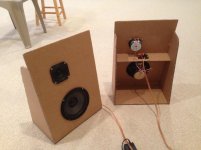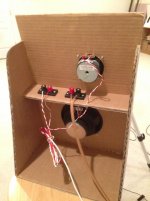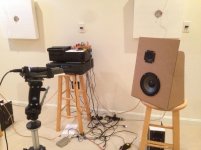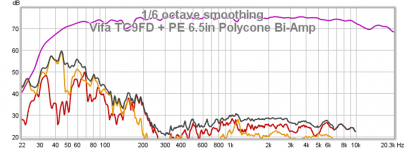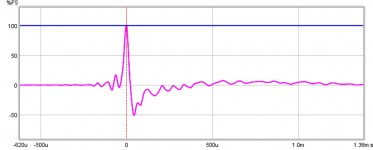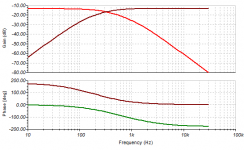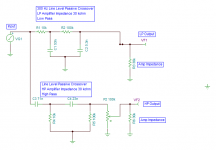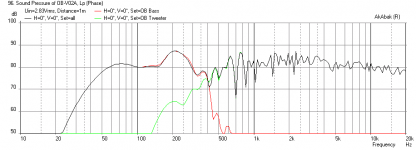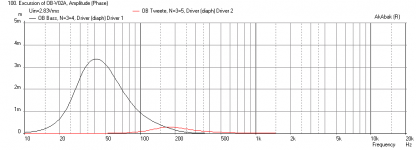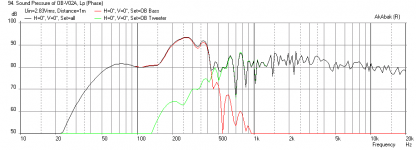Edit April 28, 2022 - XSD Speaker is here: 8x 6.5in woofers, 5.25in neodymium motor paper midrange, 3in planar dipole tweeter. 91.5dB sensitive st 2.83v, -3dB at 43Hz and -6dB at 37Hz.


Cheap and fast FAST bi-amped OB
Edit: latest results with 6 driver slot loaded woofer - see post 67.
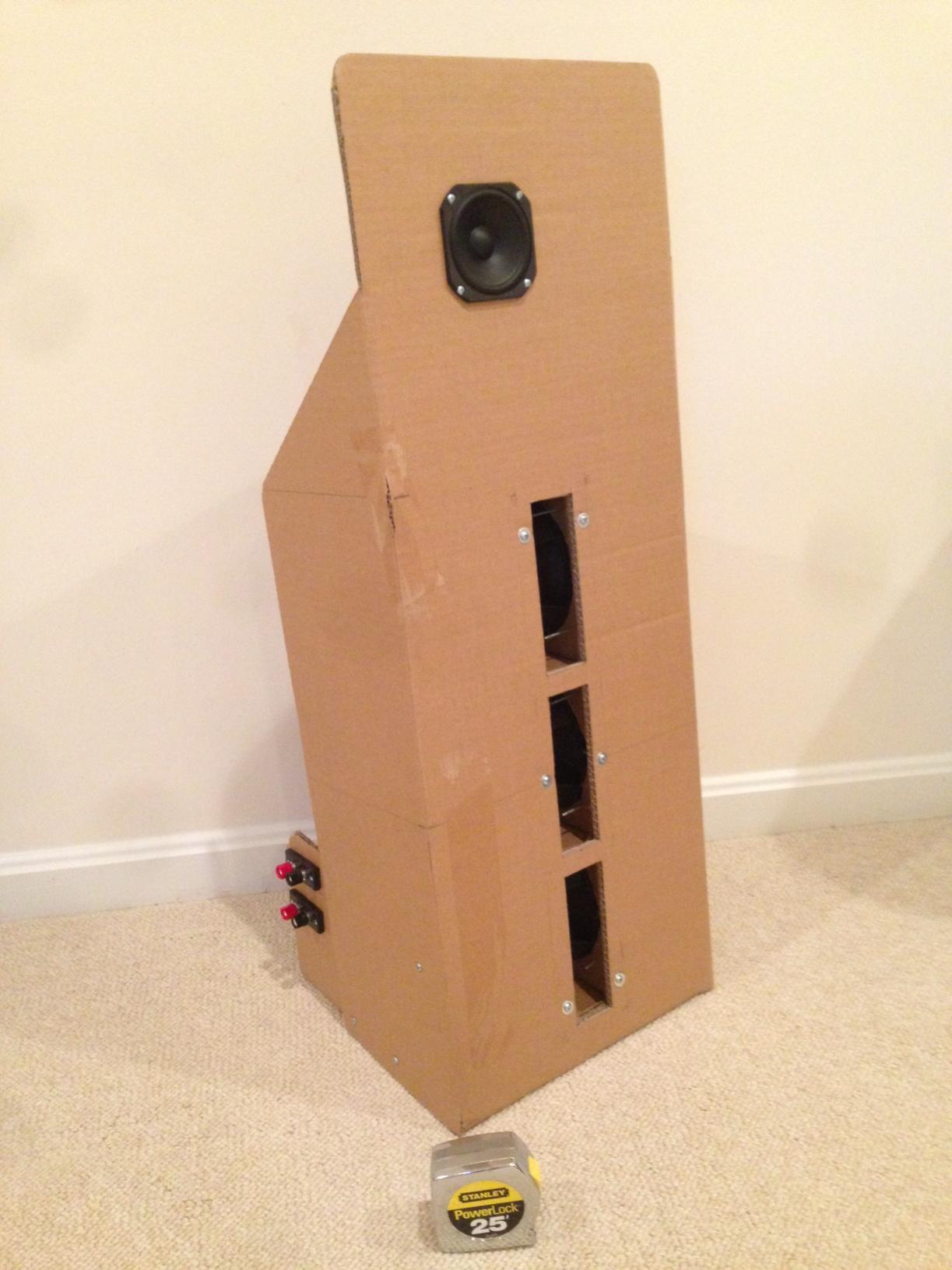
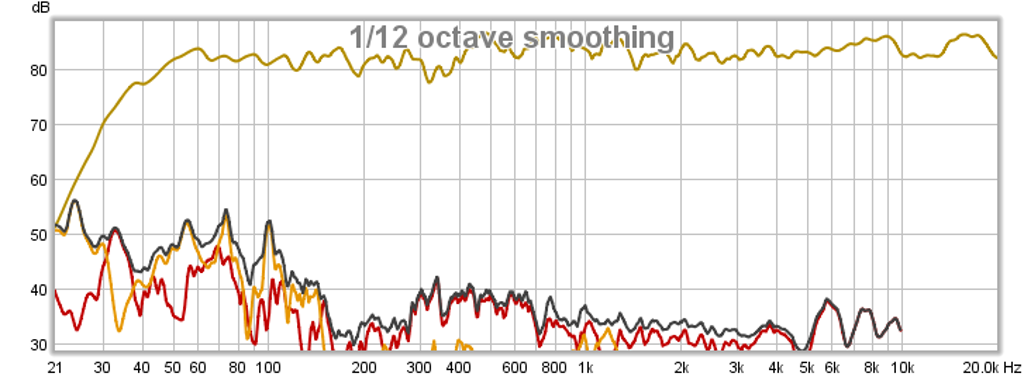
Having a bunch of Vifa TC9FD's in hand from when they had the sale for $10 ea, and a few more of the PE 6.5 in polycone woofers (part 299-609) for $4.88 ea lying around... I thought I should try a FAST open baffle, that can be made in less than 1 hr. Having measured both of these drivers in a 24 in x 36 in cardboard baffle before, I knew they had very flat responses, and being high Qts drivers would lend themselves to an OB. I also happen to now have a miniDSP to handle the XO and EQ duties, and I planned to bi-amp them. I am convinced that messing with huge inductors, and huge poly film caps for a passive XO will end up costing just as much as a minDSP and a pair of class D amps.
I happened to have some double-wall corrugated cardboard on hand that measured 12 in x 18 in. Guess what, that is now my OB baffle size. I had some more cardboard that I used to make some wings and the stand for the baffles. These ended up as 8 in deep at the base and going to 3 in deep 15 in up. I gave a tilt backwards to add stability and aim it up. The 6.5 in woofer is mounted 5 in from the bottom at the middle. The Vifa fullrange is mounted 5 in from the top and 4.5 in from one of the edges. I made it asymmetric to reduce diffraction. I added a 2.75 in deep cross brace on the back that will also come in handy for the binding posts. Everything was cut and tacked with a few points of hot melt and glued with Titebond at all seams. Cutting and gluing took 30 minutes. Screwing the drivers in and adding crimped connectors took another 15 minutes. Waiting for the glue to dry took 3 hours.
I tried running both drivers in parallel and full range to see what it sounded like - just a terrible mess. I then connected the drivers in a bi-amp configuration and driven by the miniDSP with a 24 dB/oct XO at 300 Hz.
The miniDSP setup took 15 minutes. Taking a measurement with the mic showed that it was pretty good but had a few minor dips and peaks that were easily EQ'd out. The bass extension is natural - no EQ'ing needed - it really does go to 50 Hz with the modest wings.
Here is the frequency response and distortion - nice flat response and low THD from the Vifa above 300 Hz. Below 300 Hz, the 6.5 in driver's cone excursion is starting to get taxed and hence THD goes up. Adding more woofers will reduce excursion and reduce THD. If I had more drivers, I would have used two in series for 8 ohms.
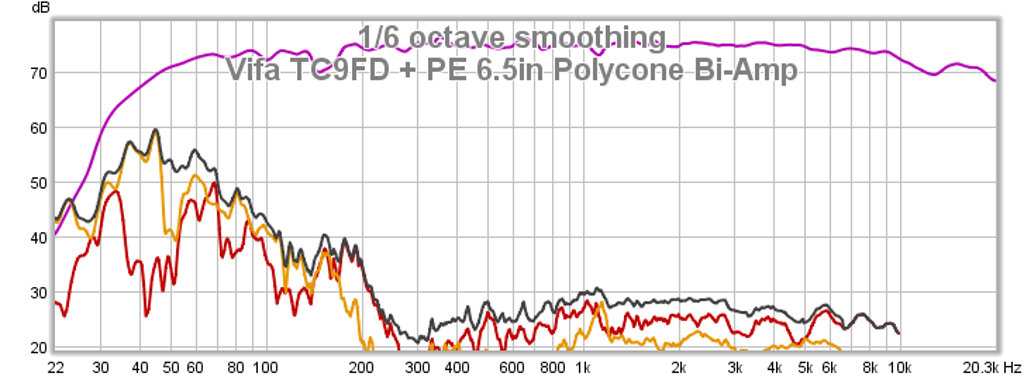
Here is the impulse response - doesn't get much better than this.
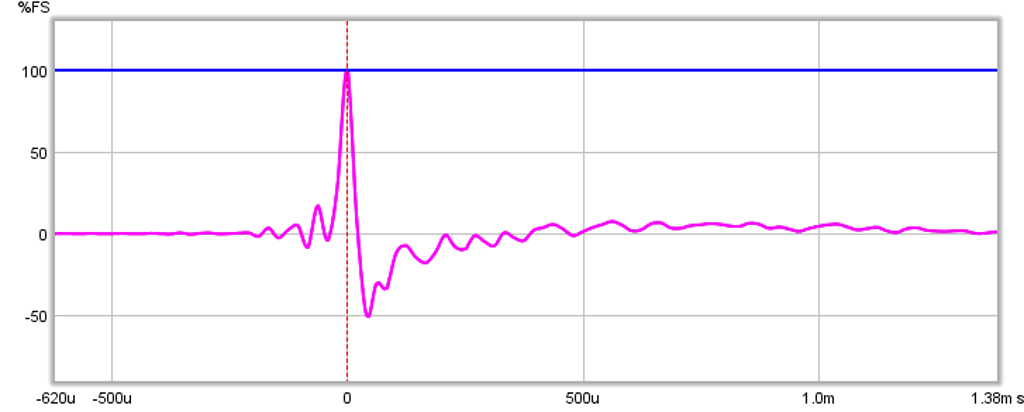
So how does it sound? Fantastic! It has some very nice clean dynamics capable of reproducing fast transients and percussion. It doesn't go very loud as the Vifa is nominally 85 dB at 2.83V but perfect for near field or low level listening. The sound stage is what is perhaps the best part - very wide and I can close my eyes and pinpoint the location of the singer, the instruments, and where they are positioned on the stage.
Anyhow, not including glue drying time, all this was done in about 90 minutes. Cost is $20 per speaker including binding posts. Now that is a cheap and fast FAST that sounds great and measures well.
Cheap and fast FAST bi-amped OB
Edit: latest results with 6 driver slot loaded woofer - see post 67.


Having a bunch of Vifa TC9FD's in hand from when they had the sale for $10 ea, and a few more of the PE 6.5 in polycone woofers (part 299-609) for $4.88 ea lying around... I thought I should try a FAST open baffle, that can be made in less than 1 hr. Having measured both of these drivers in a 24 in x 36 in cardboard baffle before, I knew they had very flat responses, and being high Qts drivers would lend themselves to an OB. I also happen to now have a miniDSP to handle the XO and EQ duties, and I planned to bi-amp them. I am convinced that messing with huge inductors, and huge poly film caps for a passive XO will end up costing just as much as a minDSP and a pair of class D amps.
I happened to have some double-wall corrugated cardboard on hand that measured 12 in x 18 in. Guess what, that is now my OB baffle size. I had some more cardboard that I used to make some wings and the stand for the baffles. These ended up as 8 in deep at the base and going to 3 in deep 15 in up. I gave a tilt backwards to add stability and aim it up. The 6.5 in woofer is mounted 5 in from the bottom at the middle. The Vifa fullrange is mounted 5 in from the top and 4.5 in from one of the edges. I made it asymmetric to reduce diffraction. I added a 2.75 in deep cross brace on the back that will also come in handy for the binding posts. Everything was cut and tacked with a few points of hot melt and glued with Titebond at all seams. Cutting and gluing took 30 minutes. Screwing the drivers in and adding crimped connectors took another 15 minutes. Waiting for the glue to dry took 3 hours.
I tried running both drivers in parallel and full range to see what it sounded like - just a terrible mess. I then connected the drivers in a bi-amp configuration and driven by the miniDSP with a 24 dB/oct XO at 300 Hz.
The miniDSP setup took 15 minutes. Taking a measurement with the mic showed that it was pretty good but had a few minor dips and peaks that were easily EQ'd out. The bass extension is natural - no EQ'ing needed - it really does go to 50 Hz with the modest wings.
Here is the frequency response and distortion - nice flat response and low THD from the Vifa above 300 Hz. Below 300 Hz, the 6.5 in driver's cone excursion is starting to get taxed and hence THD goes up. Adding more woofers will reduce excursion and reduce THD. If I had more drivers, I would have used two in series for 8 ohms.

Here is the impulse response - doesn't get much better than this.

So how does it sound? Fantastic! It has some very nice clean dynamics capable of reproducing fast transients and percussion. It doesn't go very loud as the Vifa is nominally 85 dB at 2.83V but perfect for near field or low level listening. The sound stage is what is perhaps the best part - very wide and I can close my eyes and pinpoint the location of the singer, the instruments, and where they are positioned on the stage.
Anyhow, not including glue drying time, all this was done in about 90 minutes. Cost is $20 per speaker including binding posts. Now that is a cheap and fast FAST that sounds great and measures well.
Attachments
Last edited:
Good testimony for the Manzanita OB speaker!
Fast, fun, Inexpensive OB project - Page 46 - diyAudio
(and the later version with the GRS 15" woofer)
Fast, fun, Inexpensive OB project - Page 46 - diyAudio
(and the later version with the GRS 15" woofer)
Good testimony for the Manzanita OB speaker!
Fast, fun, Inexpensive OB project - Page 46 - diyAudio
(and the later version with the GRS 15" woofer)
The Manzinita was the inspiration but I could never get over the hurdle of spending close to $200 on coils and caps for the cross over. The 15 in woofer also has a huge visual presence that makes the speaker a little too visible. I think qnty 6 x 6.5 in woofers have the same Sd as a single 15 in woofer and can have better dynamics and lower THD. I will start increasing the number of 6.5 in drivers to achieve the desired effect and I think I have a way to set them up in a push pull slot loading design that is modular.
More to come...
I am thinking of going with something along the lines of this aproach by Nelson Pass "The slot loaded Open Baffle": The Slot Loaded Open Baffle Project Article By Nelson Pass
But do it in modular 2-drive units that can be stacked as you need more surface area.
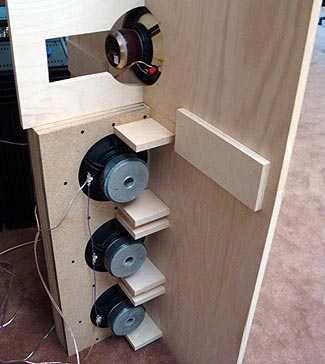
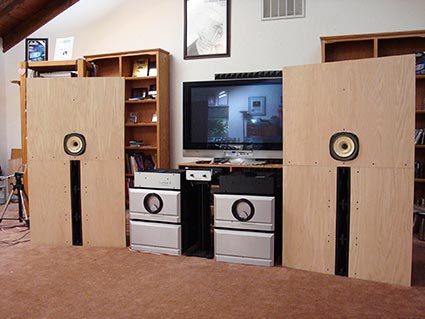
But do it in modular 2-drive units that can be stacked as you need more surface area.


Having a bunch of Vifa TC9FD's in hand from when they had the sale for $10 ea, and a few more of the PE 6.5 in polycone woofers (part 299-609) for $4.88 ea lying around... I thought I should try a FAST open baffle, that can be made in less than 1 hr. Having measured both of these drivers in a 24 in x 36 in cardboard baffle before, I knew they had very flat responses, and being high Qts drivers would lend themselves to an OB. I also happen to now have a miniDSP to handle the XO and EQ duties, and I planned to bi-amp them. I am convinced that messing with huge inductors, and huge poly film caps for a passive XO will end up costing just as much as a minDSP and a pair of class D amps.
I happened to have some double-wall corrugated cardboard on hand that measured 12 in x 18 in. Guess what, that is now my OB baffle size. I had some more cardboard that I used to make some wings and the stand for the baffles. These ended up as 8 in deep at the base and going to 3 in deep 15 in up. I gave a tilt backwards to add stability and aim it up. The 6.5 in woofer is mounted 5 in from the bottom at the middle. The Vifa fullrange is mounted 5 in from the top and 4.5 in from one of the edges. I made it asymmetric to reduce diffraction. I added a 2.75 in deep cross brace on the back that will also come in handy for the binding posts. Everything was cut and tacked with a few points of hot melt and glued with Titebond at all seams. Cutting and gluing took 30 minutes. Screwing the drivers in and adding crimped connectors took another 15 minutes. Waiting for the glue to dry took 3 hours.
I tried running both drivers in parallel and full range to see what it sounded like - just a terrible mess. I then connected the drivers in a bi-amp configuration and driven by the miniDSP with a 24 dB/oct XO at 300 Hz.
The miniDSP setup took 15 minutes. Taking a measurement with the mic showed that it was pretty good but had a few minor dips and peaks that were easily EQ'd out. The bass extension is natural - no EQ'ing needed - it really does go to 50 Hz with the modest wings.
Here is the frequency response and distortion - nice flat response and low THD from the Vifa above 300 Hz. Below 300 Hz, the 6.5 in driver's cone excursion is starting to get taxed and hence THD goes up. Adding more woofers will reduce excursion and reduce THD. If I had more drivers, I would have used two in series for 8 ohms.

Here is the impulse response - doesn't get much better than this.

So how does it sound? Fantastic! It has some very nice clean dynamics capable of reproducing fast transients and percussion. It doesn't go very loud as the Vifa is nominally 85 dB at 2.83V but perfect for near field or low level listening. The sound stage is what is perhaps the best part - very wide and I can close my eyes and pinpoint the location of the singer, the instruments, and where they are positioned on the stage.
Anyhow, not including glue drying time, all this was done in about 90 minutes. Cost is $20 per speaker including binding posts. Now that is a cheap and fast FAST that sounds great and measures well.
How much of a challenge would it be for you (assuming you were willing to take the time to do it) to design a passive crossover for this?
I'd love to try an OB, and the cost of the drivers is great (and I already have the Vifas), but I would need to go passive, at least for the time being. Is that something you could (or would be willing to) do?
I actually have the design for the passive line level XO (PLLXO) for bi amping with the tpa3116d2 (30k ohm input impedance). You do not want to go with passive speaker level XO as the price on that would be almost $200 dollars. Also, I would suggest you build the Manzanita OB if that is what you want to do. If you go with bi amping and PLLXO the amps cost $30 and the XO parts about $10. The XO has to be designed with the amp in mind as the input impedance sets the values of the resistors and capacitors in the XO.
Are you good with getting the two class D amps as part of the design? Seriously is cheaper than big coils and caps.
Are you good with getting the two class D amps as part of the design? Seriously is cheaper than big coils and caps.
Well, I can probably figure it out (one way to learn). I just recently picked up a like new Behringer 2496 active crossover (for a price I could not refuse), so maybe that would be a good way to cut my teeth???
And, yes, I plan on picking up a couple of class D amps (probably two of the the little Lapai 2020 that most people speak highly of).
Your thoughts?
And, BTW, thank you.
Coincidentally, I spent a good portion of this afternoon reading the thread on the Manzanita OB. I am impressed.
Beau
And, yes, I plan on picking up a couple of class D amps (probably two of the the little Lapai 2020 that most people speak highly of).
Your thoughts?
And, BTW, thank you.
Coincidentally, I spent a good portion of this afternoon reading the thread on the Manzanita OB. I am impressed.
Beau
Last edited:
And, yes, I plan on picking up a couple of class D amps (probably two of the the little Lapai 2020 that most people speak highly of).
Your thoughts?
Don't get the Lepai 2020, the TPA3116D2 is a superior sounding state of the art class D amp. There is a huge thread on it in the class D forum. Do a search in Aliexpress for TPA3116D2 and you will see lots of choices. Pick the YJ red board for $15 (add your own laptop brick for PS). If you want a boxed amp with knobs that will cost you $50 ea. It is a true 40 watt/ch (<0.1% THD) into 4 ohms with 19 volt PS. Get two of them for $30 shipping included. It may take 3 weeks to arrive from China. It is important to get the amp with 26 dB gain as that will make the input impedance 30kohms for the PLLXO.
If you have the Behringer DEQ then you are all set for EQ but that doesn't handle the XO. I have heard people say the analog front and rear ends on the DEQ2496 is not very good... But many people don't seem to notice.
300 Hz PLLXO Design for 30 kohm impedance amp
Here is the design for the PLLXO. There is a -12dB attenuation in the line level signal from the source through the XO so be sure you drive it with something that has some oomph - like a real RCA line out from a CD player deck or a receiver. An iPod won't cut it. Also, some 1/4 inch jack studio headphone monitor outputs from receivers or CD players can also work to drive this as they are low impedance (30 ohm drive) and have a built in volume knob if you are going straight from a CD player.
This design will only work correctly with an amp that has a 30kohm input impedance - the YJ red board TPA3116D2 amps.
Here is the PLLXO schematic:

Here is the predicted transfer function and phase:
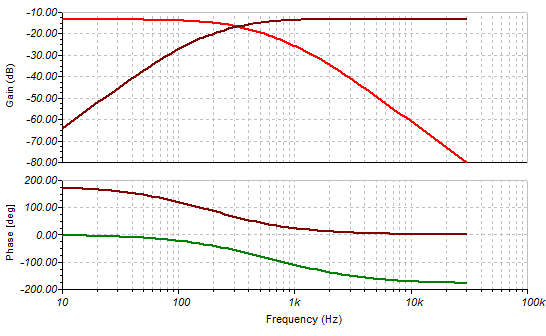
For the PE 6.5 inch woofers, I suggest using six of them to get the equivalent of a 15 inch woofer. Wire them 3 in series x 2 in parallel for 6 ohms which this amp should have no problem driving. The efficiency of 6 drivers from an 88 dB driver should be about 92 or 93 dB - perfect match for an 85 dB full range to handle the baffle step losses and OB fall-off.
I will post the design for the slot-loaded woofers later but if you look at the Nelson Pass article above you will get the idea.
Here is the design for the PLLXO. There is a -12dB attenuation in the line level signal from the source through the XO so be sure you drive it with something that has some oomph - like a real RCA line out from a CD player deck or a receiver. An iPod won't cut it. Also, some 1/4 inch jack studio headphone monitor outputs from receivers or CD players can also work to drive this as they are low impedance (30 ohm drive) and have a built in volume knob if you are going straight from a CD player.
This design will only work correctly with an amp that has a 30kohm input impedance - the YJ red board TPA3116D2 amps.
Here is the PLLXO schematic:

Here is the predicted transfer function and phase:

For the PE 6.5 inch woofers, I suggest using six of them to get the equivalent of a 15 inch woofer. Wire them 3 in series x 2 in parallel for 6 ohms which this amp should have no problem driving. The efficiency of 6 drivers from an 88 dB driver should be about 92 or 93 dB - perfect match for an 85 dB full range to handle the baffle step losses and OB fall-off.
I will post the design for the slot-loaded woofers later but if you look at the Nelson Pass article above you will get the idea.
Attachments
Actually, it is the Behringer DCX2496 Ultradrive Pro Digital Crossover. I didn't make that clear.
I hate to ask yet another newb question, but is the TPA3116D2 available already assembled and ready to use?
Sorry for learning at your expense, but I do appreciate your willingness to coach.
I hate to ask yet another newb question, but is the TPA3116D2 available already assembled and ready to use?
Sorry for learning at your expense, but I do appreciate your willingness to coach.
Yes, it comes pre-assembled. You need to connect the audio input to a small connector or solder directly onto the 3 pins.
TPA3116 Amplifier Board(50W+50W ) D Class Amplifier Board-in Amplifier from Electronics on Aliexpress.com
This could work too but I have not been able to verify the gain and input impedance.
http://www.aliexpress.com/item/TPA3116D2-amplifier-board-50w-50-w-digital-two-channel-amplifier-board-24V/1629195683.html
TPA3116 Amplifier Board(50W+50W ) D Class Amplifier Board-in Amplifier from Electronics on Aliexpress.com
This could work too but I have not been able to verify the gain and input impedance.
http://www.aliexpress.com/item/TPA3116D2-amplifier-board-50w-50-w-digital-two-channel-amplifier-board-24V/1629195683.html
Yes, it comes pre-assembled. You need to connect the audio input to a small connector or solder directly onto the 3 pins.
TPA3116 Amplifier Board(50W+50W ) D Class Amplifier Board-in Amplifier from Electronics on Aliexpress.com
This could work too but I have not been able to verify the gain and input impedance.
TPA3116D2 amplifier board 50w +50 w digital two channel amplifier board 24V-in Amplifier from Consumer Electronics on Aliexpress.com
Holy cats, its like they are giving it away!
Wow.
And, again, thank you.
Sim of OB response
I put together a model of this speaker and it is instructive to see it predicts the bass extension quite accurately and also predicts a bump at about 270 Hz due to the baffle size effect. This is well known and typically, the XO freq should be set below this point. I was able to EQ this bump out in the DSP but if you are going with a PLLXO route, the XO point will need to be lowered. The Vifa can handle a XO point as low as 200 Hz and that will help to keep the distortion lower as more of that is played through the Vifa.
Here is the predicted response for the 300 Hz XO freq (-24 dB/oct):
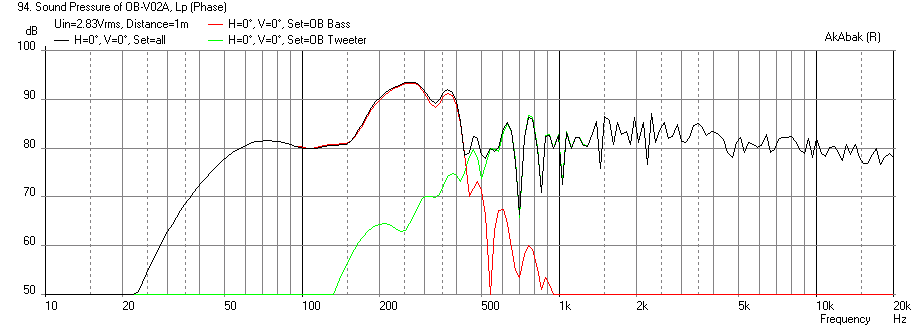
Here is the predicted response at 200 Hz XO freq:
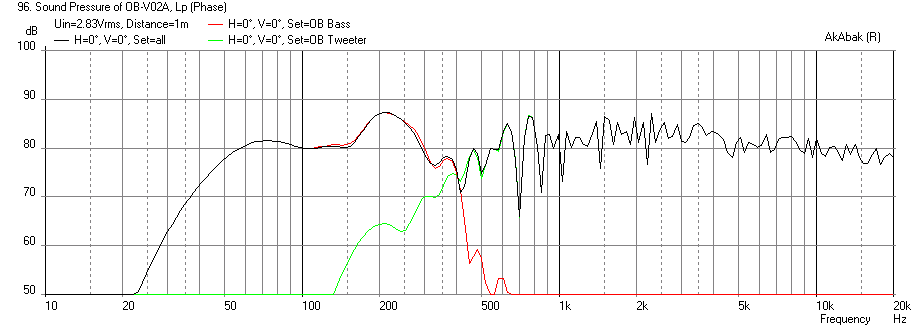
And here is the problem with using only 1 woofer as I suspected - the cone has to really move to displace the air needed for the low frequencies and will hit the 3.5 mm xmax within 2 watts of power at 40 Hz (if you have content there). Here is cone displacement at 2.83 volts:
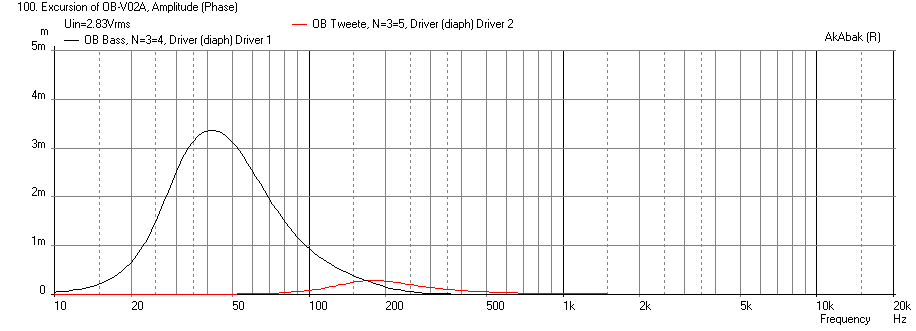
My initial guess that you need a 15 in woofer (like a Manzanita) makes sense and if you have 6 drivers then the xmax will be cut by 1/6th and be only 0.58mm instead of 3.5mm. So the way to do this is to use 6 woofers - and I plan to keep the profile of the baffle slim by going with slot loading like the Nelson Pass design. Using a 7 in tall x 7 in deep x 2 in wide box/slot will provide the recommended 30% slot area for two drivers. Stacking 3 units vertically will be 21 in tall. Adding another 9 in on top for the Vifa baffle will make it 30 in tall. A perfect height for 30 in foam core. The slop loading will provide a forward bass boost of about +2dB at 3 meters away.
I put together a model of this speaker and it is instructive to see it predicts the bass extension quite accurately and also predicts a bump at about 270 Hz due to the baffle size effect. This is well known and typically, the XO freq should be set below this point. I was able to EQ this bump out in the DSP but if you are going with a PLLXO route, the XO point will need to be lowered. The Vifa can handle a XO point as low as 200 Hz and that will help to keep the distortion lower as more of that is played through the Vifa.
Here is the predicted response for the 300 Hz XO freq (-24 dB/oct):

Here is the predicted response at 200 Hz XO freq:

And here is the problem with using only 1 woofer as I suspected - the cone has to really move to displace the air needed for the low frequencies and will hit the 3.5 mm xmax within 2 watts of power at 40 Hz (if you have content there). Here is cone displacement at 2.83 volts:

My initial guess that you need a 15 in woofer (like a Manzanita) makes sense and if you have 6 drivers then the xmax will be cut by 1/6th and be only 0.58mm instead of 3.5mm. So the way to do this is to use 6 woofers - and I plan to keep the profile of the baffle slim by going with slot loading like the Nelson Pass design. Using a 7 in tall x 7 in deep x 2 in wide box/slot will provide the recommended 30% slot area for two drivers. Stacking 3 units vertically will be 21 in tall. Adding another 9 in on top for the Vifa baffle will make it 30 in tall. A perfect height for 30 in foam core. The slop loading will provide a forward bass boost of about +2dB at 3 meters away.
Attachments
6 Driver Slot Loaded Woofer
Here is the simulation with 6 drivers pushing a 21 in tall x 7 in deep x 1.5 in wide slot for the bass located from the bottom up to 21 in. The total speaker height is 30 in and width is still a svelte 12 in wide. Vifa is located 5 in from top and 4.5 in from edge as before. I am now running a 210 Hz XO frequency (-24 dB/oct).
Here is the xmax at 15 volts drive (3-series/2-parallel wiring) for both the woofer and tweeter:
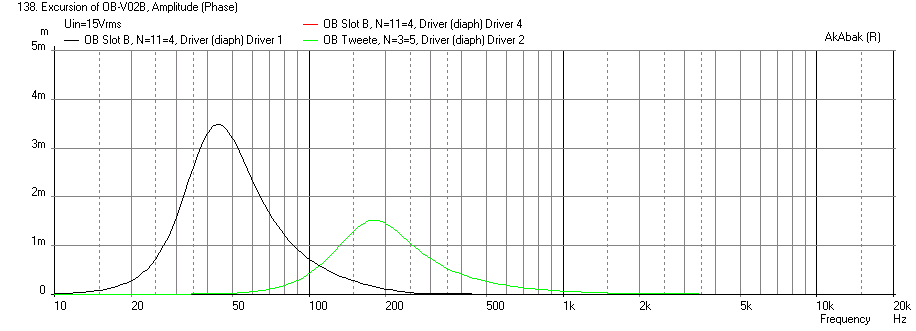
This is the max SPL corresponding to 15 volts rms:
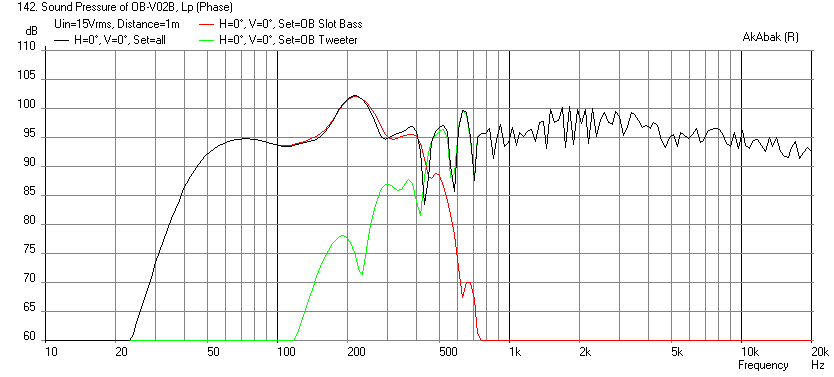
Here is the impedance for both woofer and tweeter:
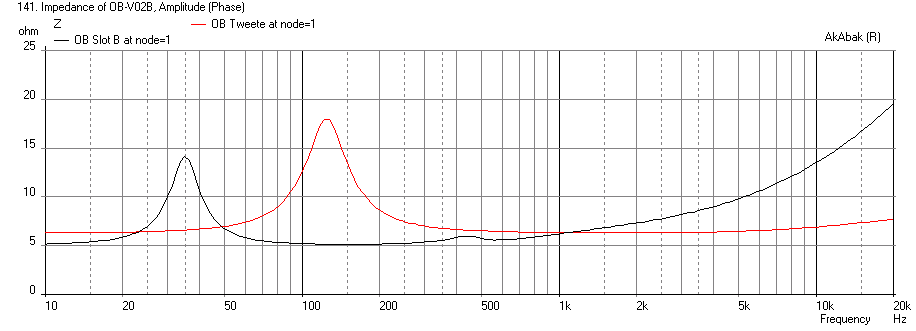
This is the impulse response which looks pretty clean and tight:
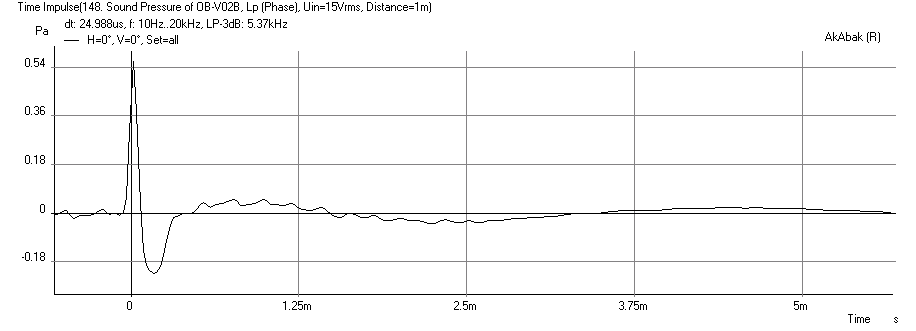
This is the air velocity at the slot exit which is well below 10 m/s to avoid chuffing:
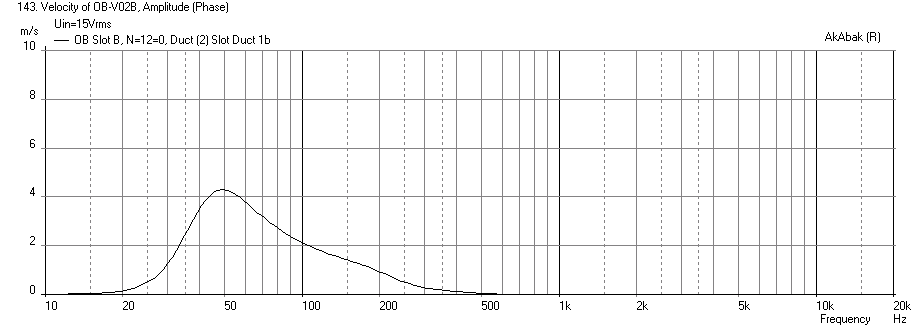
It looks like the baffle-induced bump is now at 217 Hz and will need to be EQ'd out. Although it is not a bad bump to have as peaks go.
Edit: it looks like playing with slot box dimensions is an important knob to smooth the response. Here is a 10 in deep box (allows higher drive voltage) and gives reduced bump at 217 Hz:
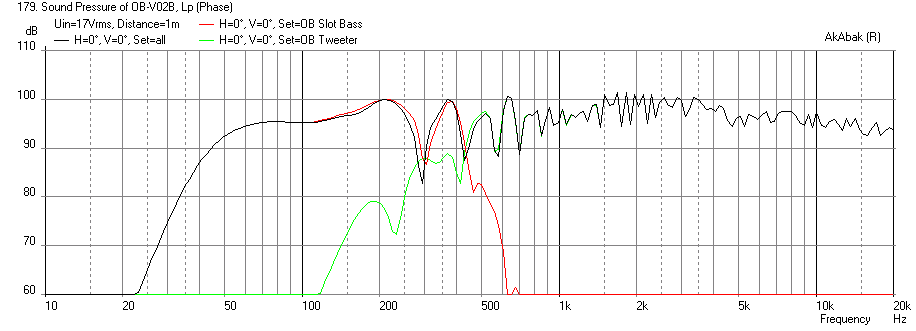
Here is the simulation with 6 drivers pushing a 21 in tall x 7 in deep x 1.5 in wide slot for the bass located from the bottom up to 21 in. The total speaker height is 30 in and width is still a svelte 12 in wide. Vifa is located 5 in from top and 4.5 in from edge as before. I am now running a 210 Hz XO frequency (-24 dB/oct).
Here is the xmax at 15 volts drive (3-series/2-parallel wiring) for both the woofer and tweeter:

This is the max SPL corresponding to 15 volts rms:

Here is the impedance for both woofer and tweeter:

This is the impulse response which looks pretty clean and tight:

This is the air velocity at the slot exit which is well below 10 m/s to avoid chuffing:

It looks like the baffle-induced bump is now at 217 Hz and will need to be EQ'd out. Although it is not a bad bump to have as peaks go.
Edit: it looks like playing with slot box dimensions is an important knob to smooth the response. Here is a 10 in deep box (allows higher drive voltage) and gives reduced bump at 217 Hz:

Attachments
-
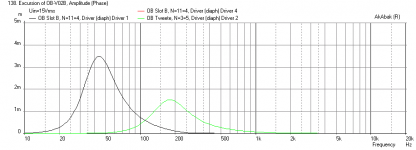 Cardboard-OB-Slot-Woofer-Displ.png25 KB · Views: 4,868
Cardboard-OB-Slot-Woofer-Displ.png25 KB · Views: 4,868 -
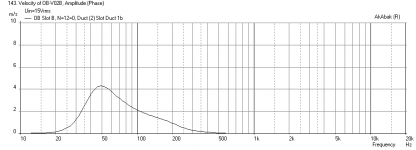 Cardboard-OB-Slot-Woofer-Max-Velocity-Slot.png22.4 KB · Views: 4,758
Cardboard-OB-Slot-Woofer-Max-Velocity-Slot.png22.4 KB · Views: 4,758 -
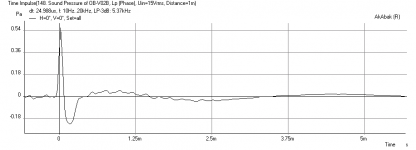 Cardboard-OB-Slot-Woofer-Impulse.png13.3 KB · Views: 4,849
Cardboard-OB-Slot-Woofer-Impulse.png13.3 KB · Views: 4,849 -
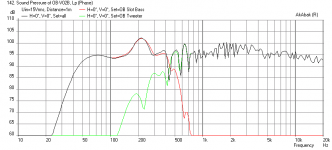 Cardboard-OB-Slot-Woofer-SPL-xmax.png27.3 KB · Views: 5,180
Cardboard-OB-Slot-Woofer-SPL-xmax.png27.3 KB · Views: 5,180 -
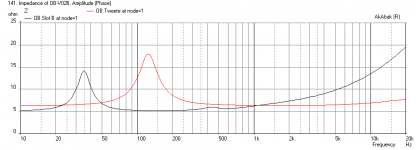 Cardboard-OB-Slot-Woofer-Impedance.png23.9 KB · Views: 4,867
Cardboard-OB-Slot-Woofer-Impedance.png23.9 KB · Views: 4,867 -
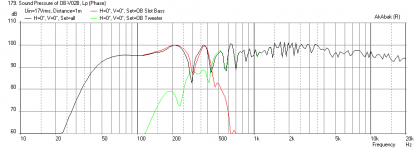 Cardboard-OB-Slot-Woofer-SPL-xmax-10indeep.png26.3 KB · Views: 4,765
Cardboard-OB-Slot-Woofer-SPL-xmax-10indeep.png26.3 KB · Views: 4,765
Last edited:
Can you explain why you have a chunk of foam wrapped around you mic? Doesn't that muck up the HF? I have a boom mic stand I use, I've tried a few things like dangling it from the wire, foam, etc. I have found just mounting it on the boom stand to be best. And I've read comments from other members that mic stands can affect HF. I can't remember where I saw it, but someone on here used a very long perfectly shaped pipe that transitioned smoothly onto the mic body. They went to great lengths to minimize HF reflection off the mic.
I'm surprised you're getting output down to 40hz with that driver / baffle. Any chance you've got off axis measurements? It would be interesting to see how that driver beams and how the OB with side walls affect the dipole behaviour. That's a nominal 3" driver?
One last thing... A FR chart on a 5db scale and 12/oct smoothing would be nice
I'm surprised you're getting output down to 40hz with that driver / baffle. Any chance you've got off axis measurements? It would be interesting to see how that driver beams and how the OB with side walls affect the dipole behaviour. That's a nominal 3" driver?
One last thing... A FR chart on a 5db scale and 12/oct smoothing would be nice
Tux,
Very perceptive of you - the mic is set in a piece of foam that cradles the larger body and allows the velcro to hold it well. The foam doesn't extend to the tip and is about 3 inches behind the microphone tip - and apparently, it doesn't seem to cause any problems with the HF measurement as you can see. It is open cell foam so really doesn't cause reflections (similar foam is sometimes used to cover mic for wind noise suppression). If I were doing near field (within inches from driver face) maybe I would be concerned but the pistol grip tripod mount would be more of a concern then. I will try to get you the 5 dB scale at 1/12 oct later.
Very perceptive of you - the mic is set in a piece of foam that cradles the larger body and allows the velcro to hold it well. The foam doesn't extend to the tip and is about 3 inches behind the microphone tip - and apparently, it doesn't seem to cause any problems with the HF measurement as you can see. It is open cell foam so really doesn't cause reflections (similar foam is sometimes used to cover mic for wind noise suppression). If I were doing near field (within inches from driver face) maybe I would be concerned but the pistol grip tripod mount would be more of a concern then. I will try to get you the 5 dB scale at 1/12 oct later.
Tux,
Regarding your question about the bass extension: I was surprised that I am getting such good extension in such a narrow OB - but then I do have 8 in deep wings that gradually taper off to 3 in deep wings - forming almost a rear H-frame. If you extended the wings and added it to the front you have 12+16=28 inches which is a pretty respectable width for an OB. Note that to get 40 Hz the driver is basically hitting its xmax which is not good. I think I am going to change the high pass filter to a 45 Hz rather than the 30 Hz. Having a Qts of almost 1 makes a big difference in ability to get deeper extension in an OB. A more pricey 6.5 in driver with a bigger motor and Qts of 0.35 will have a hard time getting to 50 Hz. My big problem is that these drivers are out of stock and more will not be availabel until April. The cost of 6 of these drivers is about the same as a single 15 in GRS used in the Manzanita. I think having 6 smaller drivers will have an improvement in the dynamics and impulse response (plus it provides an asymmetric throw that enhances forward SPL over backwave SPL, and it looks more compact and cool as a slot loaded woofer). The full range driver is a nominal 3.5 inch unit - no beaming at all with this driver as it is small.
Regarding your question about the bass extension: I was surprised that I am getting such good extension in such a narrow OB - but then I do have 8 in deep wings that gradually taper off to 3 in deep wings - forming almost a rear H-frame. If you extended the wings and added it to the front you have 12+16=28 inches which is a pretty respectable width for an OB. Note that to get 40 Hz the driver is basically hitting its xmax which is not good. I think I am going to change the high pass filter to a 45 Hz rather than the 30 Hz. Having a Qts of almost 1 makes a big difference in ability to get deeper extension in an OB. A more pricey 6.5 in driver with a bigger motor and Qts of 0.35 will have a hard time getting to 50 Hz. My big problem is that these drivers are out of stock and more will not be availabel until April. The cost of 6 of these drivers is about the same as a single 15 in GRS used in the Manzanita. I think having 6 smaller drivers will have an improvement in the dynamics and impulse response (plus it provides an asymmetric throw that enhances forward SPL over backwave SPL, and it looks more compact and cool as a slot loaded woofer). The full range driver is a nominal 3.5 inch unit - no beaming at all with this driver as it is small.
Last edited:
xrk,
I think I'd take the multiple smaller drivers over a larger one as well, but mostly for flexibility of tackling room placement. I'm not sure it would affect the impulse response. The impulse response is going to be largely dictaded by the Vifa full range. Don't forget that IR is just what the mic hears, which then describes the frequency response and CSD via the Fast Fourier Transform. The woofers are only working up to 300hz, so you're looking at the 4ms and longer range. I bet if you measured the woofer alone, you'd have a very flat looking IR. Then measure the full range and the IR will look very similar to both drivers combined. The full range dominates.
Will you arrange the woofers vertically to get an array effect? Is that what you mean by "asymmetric throw that enhances forward SPL over backwave SPL"? I'd agree this will tame any vertical room issues you might have. Nice woofer choice for this app. Obviously it payed off. With multiples you won't have your xmax problem either.
How do you like your minidsp? I love mine for trying FASTs. They're really slick. I have mine tied up in my subwoofer system right now. I gotta either get another, or buy an amp with built in DSP to free up my mini.
I think I'd take the multiple smaller drivers over a larger one as well, but mostly for flexibility of tackling room placement. I'm not sure it would affect the impulse response. The impulse response is going to be largely dictaded by the Vifa full range. Don't forget that IR is just what the mic hears, which then describes the frequency response and CSD via the Fast Fourier Transform. The woofers are only working up to 300hz, so you're looking at the 4ms and longer range. I bet if you measured the woofer alone, you'd have a very flat looking IR. Then measure the full range and the IR will look very similar to both drivers combined. The full range dominates.
Will you arrange the woofers vertically to get an array effect? Is that what you mean by "asymmetric throw that enhances forward SPL over backwave SPL"? I'd agree this will tame any vertical room issues you might have. Nice woofer choice for this app. Obviously it payed off. With multiples you won't have your xmax problem either.
How do you like your minidsp? I love mine for trying FASTs. They're really slick. I have mine tied up in my subwoofer system right now. I gotta either get another, or buy an amp with built in DSP to free up my mini.
- Home
- Loudspeakers
- Full Range
- Cheap and FAST OB, Literally
